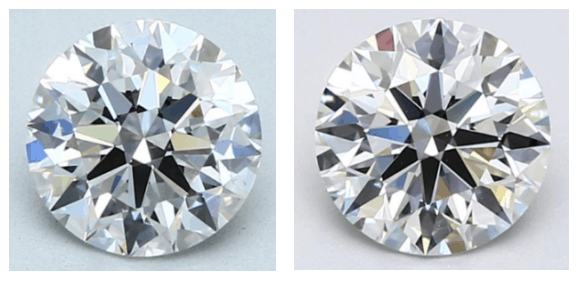We are reader-supported. Buying through any red colored link on our site may earn us commissions. Learn More.
Up to 30% off engagement rings and select jewelry at James Allen!
What is Diamond Polish?
Diamond polish refers to the quality of the surface finish of the diamond after it has been cut and faceted. In simple terms, it measures how smooth the various facets of a diamond are, impacting how cleanly the diamond reflects light. The quality of polish can range from “Poor” to “Excellent,” and it plays a significant role in determining a diamond’s overall appearance and value. While polish is generally less critical than other factors like cut, color, and clarity, a higher quality of polish can subtly enhance a diamond’s brilliance and sparkle.
When shopping for a diamond, it’s recommended to aim for a polish grade of “Very Good” or “Excellent” for the best aesthetic effect, as these categories usually don’t significantly inflate the diamond’s price. Lower grades like “Fair” or “Poor” can result in a diamond that appears dull or cloudy, diminishing its overall appeal.
“Diamond polish is the smoothness of the facet surfaces and the condition of the facet edges.”
“When diamond graders assess diamonds for polish and symmetry, the visibility, as well as the number of faults, are taken into consideration. As with diamond clarity, polish and symmetry are assessed and assigned grades at 10x magnification under a standardized lighting environment.” American Gem Society (AGS)
A rough diamond often has miniscule crystal bumps present on the facets. When a diamond is polished, those bumps are removed. By using a fine grain diamond dust on a polishing wheel and polishing for a long time, a gemologist achieves higher polish grades.
Diamond Polish Grade: Which grade should you choose?
Diamond polish grades are given based on the smoothness of each facet. A gemologist reviews the diamond under magnification to determine the polish grade. We recommend diamonds that have Excellent, Very Good or Good polish grades. Diamonds with a lower polish grade (Fair and Poor) won’t reflect light as well and may appear dull.
Why you should trust us
Here are the GIA polish grades:
Excellent: No polish flaws are visible under 10x magnification (standard jeweler’s loupe).
Very Good: Polish flaws are very difficult to spot under 10x magnification.
Good: Polish flaws are somewhat difficult to find with 10x magnification.
Fair: Some polish flaws are seen under 10x magnification and may also be visible to the naked eye. These diamonds are not recommended.
Poor: Flaws are visible under magnification and to the naked eye. These diamonds are not recommended.
A variety of flaws can affect a diamond’s polish grade. As the GIA explains, features that are taken into account in a polish assessment include abrasions (scratches or pits), burns (a type of whitish haze on a diamond’s surface), laser manufacturing remnants, notches and other issues that affect the texture of a diamond.
Does Diamond Polish matter?
Diamond polish does impact a diamond’s beauty and brilliance, but not as much as you might think.
With over six years of experience in the diamond industry and working for one of the largest and most well-respected firms in the world, I cannot distinguish between an “Excellent” Polish diamond, a “Very Good” Polish diamond or even a “Good” Polish diamond.
Technically speaking, “Excellent” Polish diamonds have been polished longer on the polishing wheel with a finer grain of diamond dust. But the simple fact is, if I can’t tell the difference with a 10x loupe, there’s no way I’ll be able to perceive a difference without magnification. So there’s no reason to pay for it.
While it might look nice on a piece of paper to have a pretty word like “Excellent” written under Polish, it’s certainly not worth paying extra for. It’d be like a car salesman convincing you to purchase a $5000 upgrade package for a “friendlier cabin aura.”
Instead of searching for an “Excellent” diamond polish grade, it’s more important to look for a well cut diamond with plenty of brilliance. Besides looking at the diamond cut grade, review the diamond up-close to see how brilliant it is. For example, this stunning 0.8 Carat True Hearts diamond from James Allen offers an incredible amount of brilliance. The light reflects well off of the diamond’s table and facets. A diamond like this makes for a truly stunning engagement ring.
Look at this comparison of two diamonds from Blue Nile, a 1.53ct F/VS1 Round diamond with Excellent polish (left) and a 1.50ct F/VS1 Round diamond with Very Good polish (right). Inclusions aside, they look virtually identical.
Impact of Diamond Polish on Price
A diamond’s polish grade can impact the price, but not as significantly as other qualities. Most Excellent cut diamonds also have “Excellent” polish, though some of these diamonds may have a “Very Good” or “Good” polish grade. A lower Polish graded diamond might be priced slightly less, saving you a few dollars, depending on the other qualities of the diamond.
Most GIA graded diamonds have an Excellent polish, though. In fact, there are so few GIA Very Good polish diamonds, that they’re usually more expensive than Excellent polish diamonds. Because Excellent polish grade diamonds are so common, a lot of sellers have diamonds certified by not-so-strict labs. They go with a more lenient lab because they don’t want to carry Very Good polish graded diamonds.
When you shop for diamonds, it’s most important to be on the lookout for a beautifully cut diamond with plenty of brilliance (rather than a certain Polish grade). As long as the Polish grade is Good or better, the diamond’s beauty won’t be impacted by polish flaws since they won’t be visible to the naked eye. If you can save some money going for a slightly lower Polish grade, it’s fine to do so.
Polish Features
Many factors play into a diamond’s Polish grade and quality. Most diamonds have some miniscule polish marks on its facets. These tiny blemishes range in nature and color.
Here are the features the GIA considers when assigning a Polish grade:
Nick: Tiny notch on a girdle junction or facet.
Scratch: Transparent-looking line on the diamond’s surface.
Pit: Small divot usually caused by a pinpoint inclusion that fell out of their pocket during polishing.
Abrasion: Small nicks that are close together near facet functions.
Polish line: Hardly visible fine line that’s translucent or white.
Burn mark: White-like haze caused by high temperatures from the polishing wheel or jeweler’s torch.
Lizard skin: Bumpy texture on a diamond’s surface or facets.
Rough girdle: An unpolished girdle.
The combination of these features impacts the Polish grade and quality. If one of these features is especially large or noticeable, it reduces the overall grade.
Which is more important – diamond polish or symmetry?
Diamond symmetry is slightly more important than diamond polish. A diamond’s symmetry is how well aligned the facets are. When a diamond has asymmetrical features like an off-center table or misshapen facets, it can impact how well light reflects off of the diamond.
In general though, it’s impossible to tell the difference between a diamond with “Excellent” symmetry and “Very Good” symmetry, just as it’s impossible to see the difference between “Excellent” and “Very Good” Polish diamonds. As long as you choose a diamond with “Good” or better symmetry and “Good” or better polish, your diamond won’t be negatively impacted by these features.
For help in reviewing diamonds for Polish and other characteristics, send our experts a note.
Wondering how to polish a diamond?
By keeping your engagement ring clean, you help maintain its brilliance. While you won’t technically be polishing your diamond (like a professional gemologist does before they sell you the ring), you can clean your engagement ring safely with soap and water. You can also polish your ring setting and check it to ensure there are no loose prongs.

- No questions asked returns within 30 days of shipment. James Allen will send you a paid shipping label to return the ring.
- Lifetime Warranty
- Free International Shipping
- Free prong tightening, repolishing, rhodium plating and cleaning every 6 months
- Provide insurance appraisals
- One free resizing within 60 days of purchase
- Free ring inscriptions
- Best-in-class high quality imagery of all diamonds in stock
- 24/7 Customer Service
- Best-in-class packaging


- No questions asked returns within 30 days of shipment. Blue Nile will send you a paid shipping label to return the ring.
- Lifetime Warranty
- Free Shipping
- Free prong tightening, repolishing, rhodium plating and cleaning every 6 months
- Provide insurance appraisal
- One free resizing within the first year of purchase
- High quality images of about half of their diamonds
- 24/7 Customer Service
- 100% credit towards future upgrades (must be at least double in value)
- Best in class fulfillment

Still afraid of getting ripped off?
Before you buy a diamond, get personal buying advice from industry veterans. We'll help you get the best diamond for the money.
Ask your diamond purchase question here
DISCLAIMER: We don't use your email for marketing. Period.
You Might Like
Diamond Prices: A Complete Guide
A diamonds’ price is determined primarily by the 4 Cs of the diamond. On the wholesale level, diamond prices are first based on a diamond shape and
The Best Places to Buy Engagement Rings
Buying an engagement ring is often one of the first major purchases in a person's life. The process can be fraught with tension as there are so m
1 Carat Diamond Price & Buying Guide
A wide range of 1 carat diamonds exist both in online markets and local diamond jewelry stores. Not only are there significant differences in beauty




